Teen e-cigarette use is on the rise. Here's what we know and don't know (and why parents should be alarmed)
Nearly 5 million American high school and middle school students used tobacco products in 2018, with a dramatic increase in e-cigarette use anchoring the statistics. That has public health and other officials sounding an alarm for parents and young users.
Health officials say e-cigarette manufacturers target youths with flavors like bubblegum and cotton candy and present e-cigs in forms divorced from traditional notions of e-cigs, making it easier to hide use of the tobacco products from parents and other adults.
Mod-pods by Juul, for example, look like a USB flash drive.
More concerning, these experts add, is difficulty telling exactly what's in the products and the fact few studies have been done to document potential harm.
The numbers and a specific warning about what's at stake were issued this month by the Centers for Disease Control and Prevention in a Vital Signs report. The first line in the bulletin says that "tobacco use is the leading cause of preventable disease and death in the United States; nearly all tobacco product use begins during youth and young adulthood."
"Use has just exploded," said Ellen J. Hahn, a professor at University of Kentucky and director of the Breathe program there. She noted traditional tobacco companies are purchasing stakes in popular e-cig manufacturing companies.

"It's important to know that the surgeon general said that e-cig use has become an epidemic nationwide. We need to focus on preventing it, especially among youths, because research shows nicotine impact on developing brains," said Ryan Bartlett, spokesman for the Utah Department of Health's Tobacco Prevention and Control Program.
Even in Utah, which has lower teen smoking rates than many states, reports show recent use of e-cigs by 11.1 percent of teens surveyed in eighth, 10th and 12th grades — a number that doubled in the last five years, Bartlett said. Fewer than 3 percent reported using actual cigarettes.
Surveys show many young e-cig users don't even know they contain tobacco products, he added.
The CDC report, which asked about use within the last 30 days, found that 27.1 percent of high school students (4.04 million teens) and 7.2 percent of middle schoolers (570,000) report "current use" of any tobacco product. The report also states that 1 in 5 students in high school smoked e-cigs, as did nearly 5 percent of middle school students, based on the National Youth Tobacco Surveys
Those numbers mark a significant increase in e-cigarette use. That, combined with no drop in use of other tobacco products "has erased recent progress in reducing overall tobacco product use among youths," the CDC reported.
What's known or believed
E-cigs have been deemed by both the courts and the Food and Drug Administration to be tobacco products, "though the industry likes people to think they're something else," Hahn said.
Dr. Indra Cidambi, addiction specialist, psychiatrist and medical director of the Center for Network Therapy in West Orange, New Jersey, describes e-cig use this way: "Vaping is a method of inhaling nicotine and marijuana as of now, but we expect it to expand to other drugs over time."
She said e-cigs essentially heat up the e-liquid ("nicotine or marijuana") in a cartridge and vaporize it.
Some, including Hahn, prefer "aerosolize" to "vaporize" as a description of the process.
Aaron Thorup, Tobacco Product Use Among Middle and High School Students — United States, 2011-2018. Morbidity and Mortality Weekly Report (MMWR), February 2019.
Some experts believe e-cig products may help adults smokers quit. A study recently published in the New England Journal of Medicine paired e-cigs with behavioral therapy and compared it to nicotine replacement therapy, finding those using the device and therapy more apt to quit smoking. A 2014 cross-sectional study, also from the United Kingdom, is often quoted for finding that "among smokers who have attempted to stop without professional support, those who use e-cigarettes are more likely to report continued abstinence" than those who used over-the-counter nicotine replacement or who tried to stop smoking cold turkey.

The relevance to teens is different, and public health experts want to prevent teens from using any tobacco products before they begin. But they warn that e-cig device manufacturers are targeting young people, who in turn are more likely than those who don't use the electronic devices to become traditional tobacco product users, too.
Cidambi said e-cigs eliminate risk from harmful chemicals associated with the paper in cigarettes but "usually increase the concentration of nicotine or marijuana, providing a bigger kick." And e-cigs contain other chemical additives, such as propylene glycol and glycerol, that are toxic and have been linked to cancer, respiratory disease and heart disease.
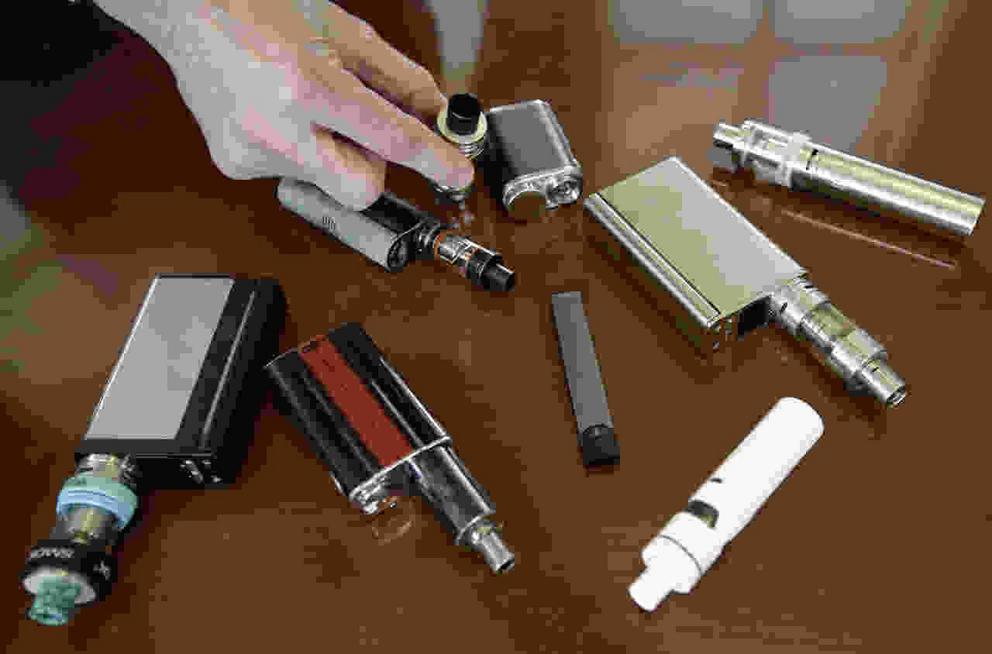
Steven Senne, Associated Press
In this Tuesday, April 10, 2018, file photo, a high school principal displays vaping devices that were confiscated from students in such places as restrooms or hallways at the school in Massachusetts. The Food and Drug Administration is planning on requiring strict limits on the sale of most flavored e-cigarettes, including age verification controls for online sales, in an effort to curtail their use among children and teenagers.
A chemical used to flavor some e-liquids, she noted, may also cause "scarring and obstruction of the lungs' smallest airways — also referred to as popcorn lung."
Research and regulation have lagged far behind innovation by manufacturers, according to Hahn. Right now, there's not even premarket review.
"It's still kind of the wild, wild West, though I hate to say it," Hahn said. "… But the industry is way out in front."
That includes sophisticated advertising, including on youth, through targeted social media, said Hahn. E-cig device manufacturers also use venues and events to establish name familiarity, including sponsoring music festivals or interactive photo booths at popular events like concerts. And while laws forbid free samples of traditional tobacco products, some manufacturers distribute e-cig products because that's not banned.
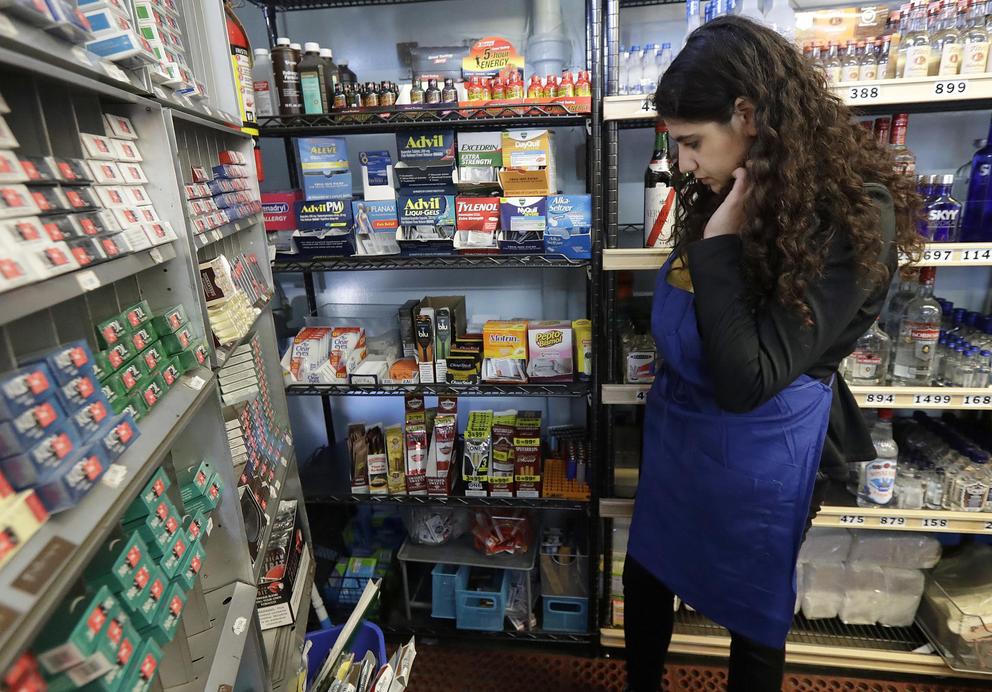
Jeff Chiu, Associated Press
In this May 17, 2018, photo, Miriam Zouzounis looks through a selection of tobacco products while interviewed at Ted's Market, her family's store, in San Francisco. R.J. Reynolds Tobacco Co. is pumping millions of dollars into a campaign to persuade San Francisco voters to reject a ban on selling flavored tobacco products, including menthol cigarettes and vaping liquids with flavors like cotton candy, mango and cool cucumber.
Hahn says the marketing evokes "deja vu" for those who have worked for years to prevent tobacco use.
Nor is usage the only thing climbing when it comes to e-cigs: In at least some of the devices, experts warn that nicotine levels could be higher than in traditional, combustible tobacco products.
"They can be very addictive" and are becoming more so, said Bartlett, who added that one "need not puff on them as much to get the same effect."
A particular concern is that e-cig use has been shown to increase risk of using traditional combustible tobacco products, with the well-documented harms that entails. And some users may embrace both cigarettes and their electronic kin.
"We do know that electronic cigarettes can deliver nicotine at levels similar to cigarettes, so using them places teens at risk of dependence and persistent smoking," said Hahn.
Another concern spawned specifically about Juul's mod-pods is that they use nicotine salt. "That's a little variation that allows nicotine delivery more efficiently and at higher levels," Hahn said.
What isn't known
Because e-cigs involve heat that aerosolizes the product, experts aren't sure exactly how they compare when it comes to lung damage. But Bartlett and Hahn both note research that says aerosols can be harmful to different systems in the body, especially heart, lung and circulation.
"We know most (e-cigarettes) contain potentially toxic chemicals, but the amounts are highly variable, which makes it tough to study," Hahn said. Although at least some of the chemicals are known to be "highly toxic," lack of regulation makes it hard to study, too. They have been proven toxic in combustibles (products one lights), but not necessarily in non-combustible form.
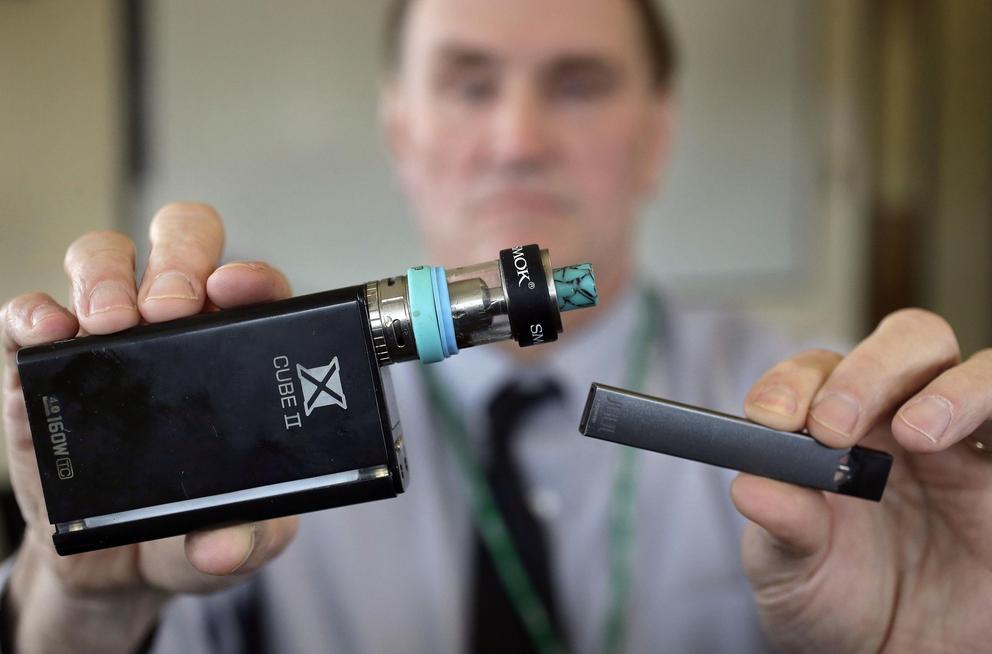
Steven Senne, Associated Press
In this Tuesday, April 10, 2018, photo Marshfield High School Principal Robert Keuther displays vaping devices that were confiscated from students in such places as restrooms or hallways at the school in Marshfield, Mass. Health and education officials across the country are raising alarms over wide underage use of e-cigarettes and other vaping products.
Hahn cites national data showing that among adults, 70 percent of e-cig users also use combustible tobacco. E-cig critics believe e-cigs increase the risk that teens will go on to use combustibles too.
Little is known about what individual vaping products contain and at what level. Hahn calls the products a "witches' brew," with nicotine, flavorings and chemicals, their recipes unknown.
Cidambi said she fears that "eventually teenagers will develop tolerance to nicotine and will seek more potent stimulants to release increased amounts of dopamine to get the same euphoric effect" that leads them to use the electronic devices.
And she wonders what future e-liquids will be developed for use in the devices.
"In my opinion, it is inevitable that high-potency drugs will eventually be sold as vapable e-liquids," she said.
What's needed
Policy makers and public health experts said more research in use of e-cigarette devices should be prioritized to answer some of the questions that usage raises. While there's some short-term data, little is known about long-term use.
"What we need to do is really sound science, with clinical trials and not just observational," said Hahn. "That will help us weigh the balance between adverse and potentially positive" issues, such as whether e-cigarette use signficantly helps smokers quit. "Maybe it really helps some; we just don't know. We need real-life trials."
What science clearly shows already does help smokers quit, she said, is a combination of FDA-approved medication and behavioral techniques.
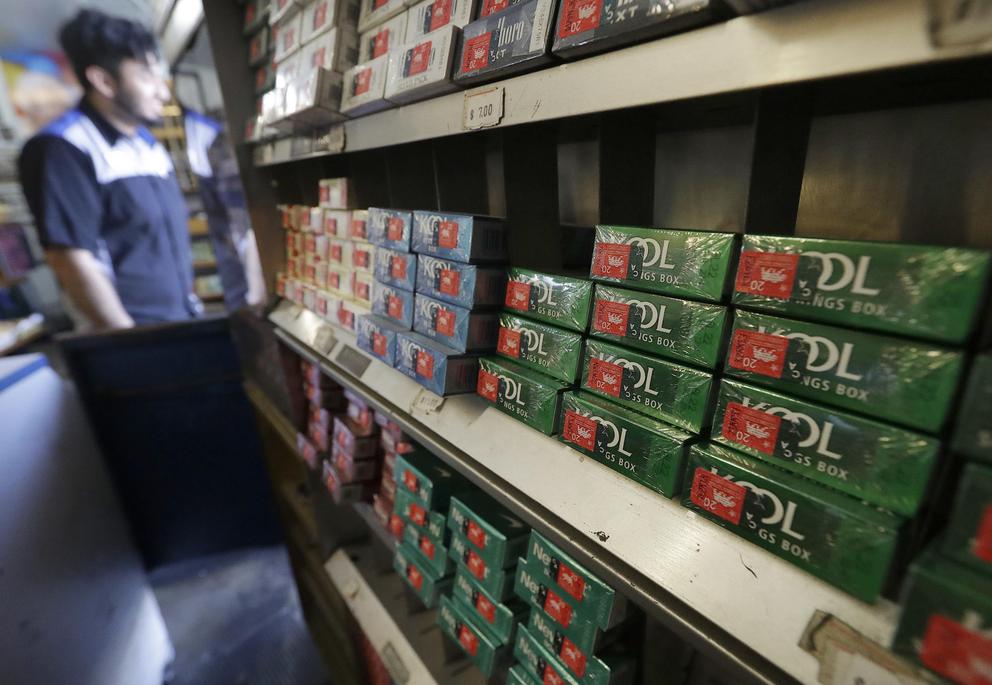
Jeff Chiu, Associated Press
This May 17, 2018, photo shows packs of Kool menthol cigarettes displayed with other tobacco products at Ted's Market in San Francisco. R.J. Reynolds Tobacco Co. is pumping millions of dollars into a campaign to persuade San Francisco voters to reject a ban on selling on flavored tobacco products, including menthol cigarettes and vaping liquids with flavors like cotton candy, mango and cool cucumber.
Public health experts also told the Deseret News they want to better understand the impact of industry marketing, particularly that aimed at youths, including how marketing influences decision-making when it comes to using e-cigs.
"We need more research on youth. My best hypothesis is youths are using because (e-cigarettes) are easy to use, they can hide them and they get lots of messages about them that say they perhaps might be safer. We don't know that, but they might be," Hahn said.
She is among those recommending parents and others look closely at the disclosures on research studies to see if there are financial conflicts of interest for those conducting the study. Researchers who have a conflict are more likely to find a product offers reduced harm or no harm, she said.
When an industry player pays for research that reports no harm, Hahn said, "people need to be very skeptical of what they're reading. That's important."
The safest bet, according to the CDC, FDA and other public health experts, is not using any tobacco product at all.
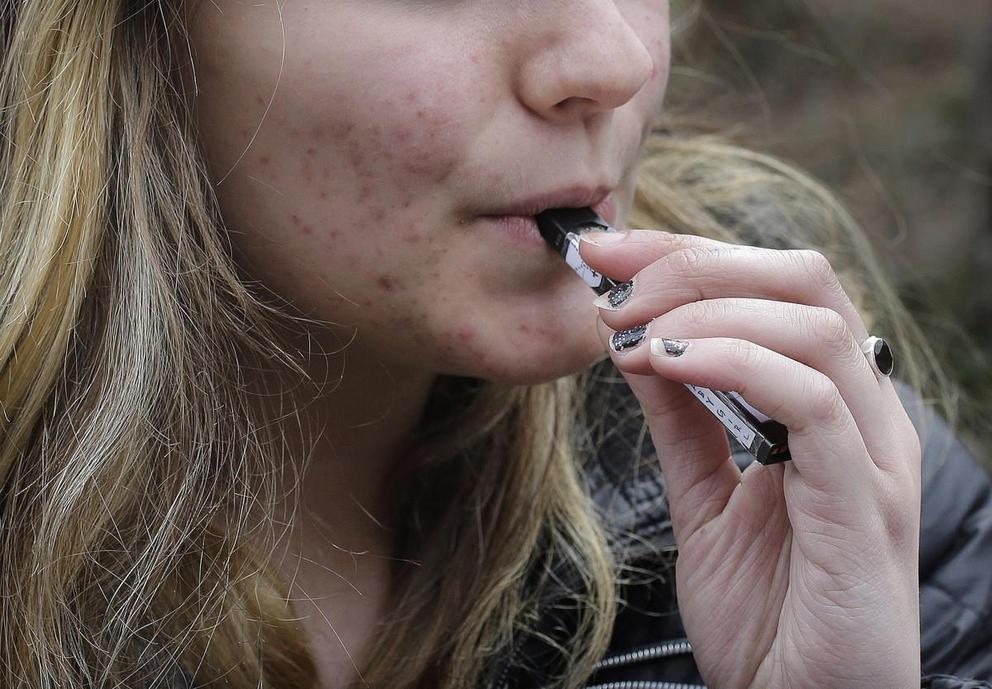
Steven Senne, Associated Press
In this April 11, 2018, file photo, an unidentified 15-year-old high school student uses a vaping device near the school's campus in Cambridge, Mass. A school-based survey shows nearly 1 in 11 U.S. students have used marijuana in electronic cigarettes, heightening concern about the new popularity of vaping among teens. E-cigarettes typically contain nicotine, but results published Sept. 17, 2018, mean a little more than 2 million middle and high school students have used the devices to get high.
